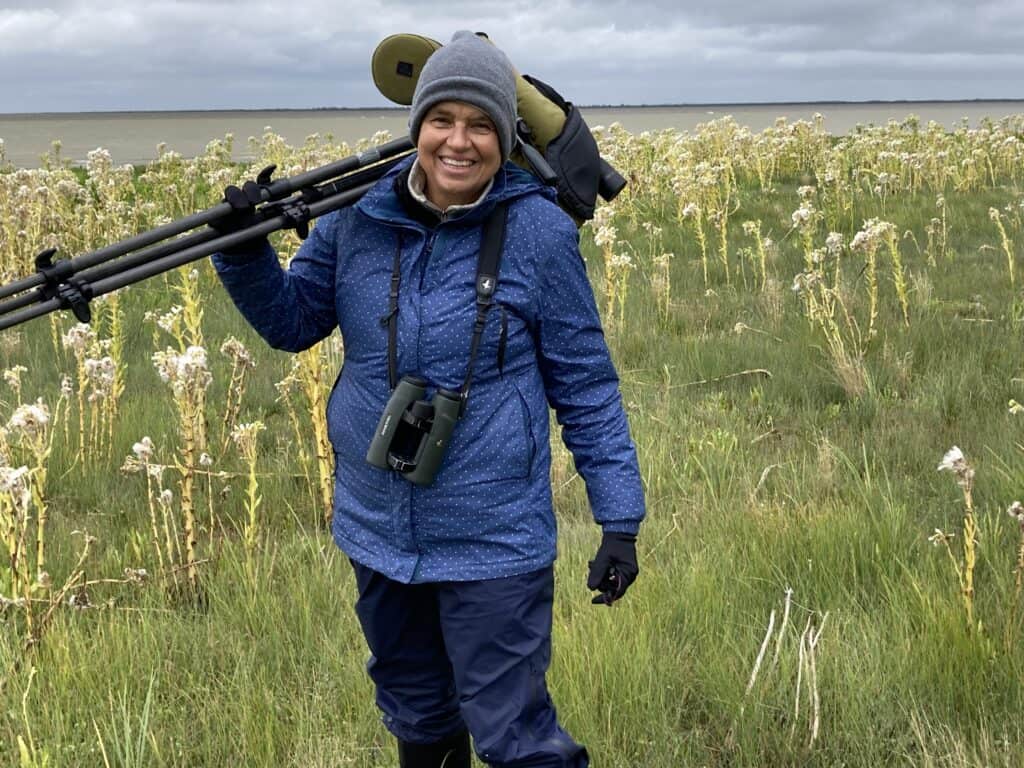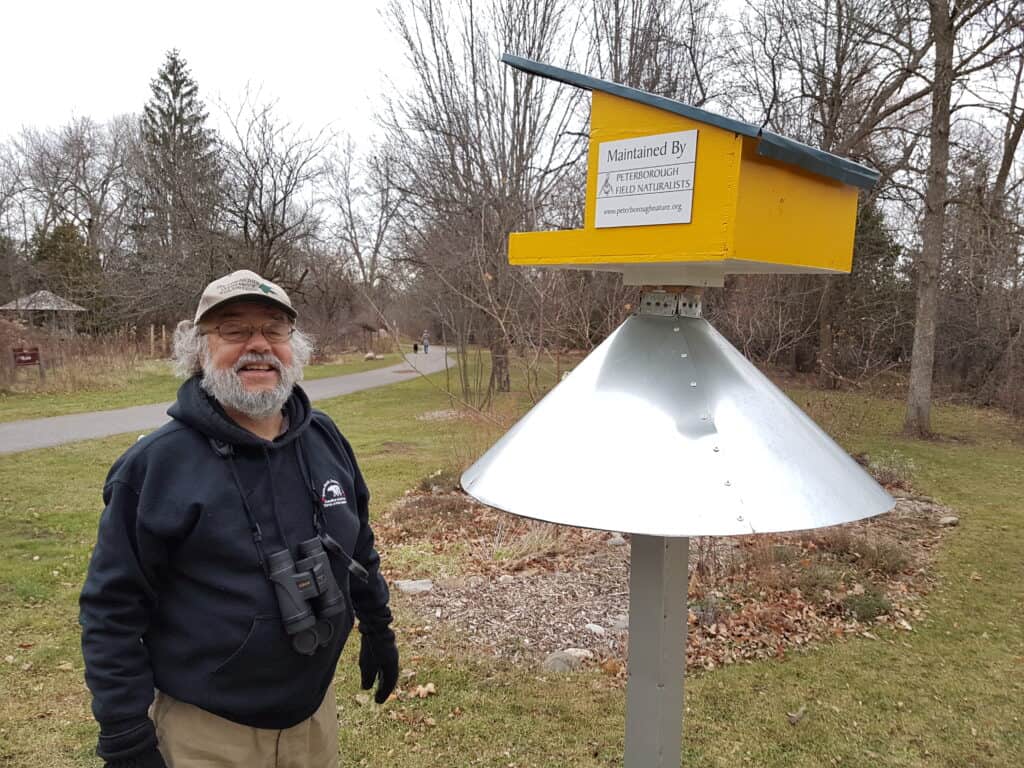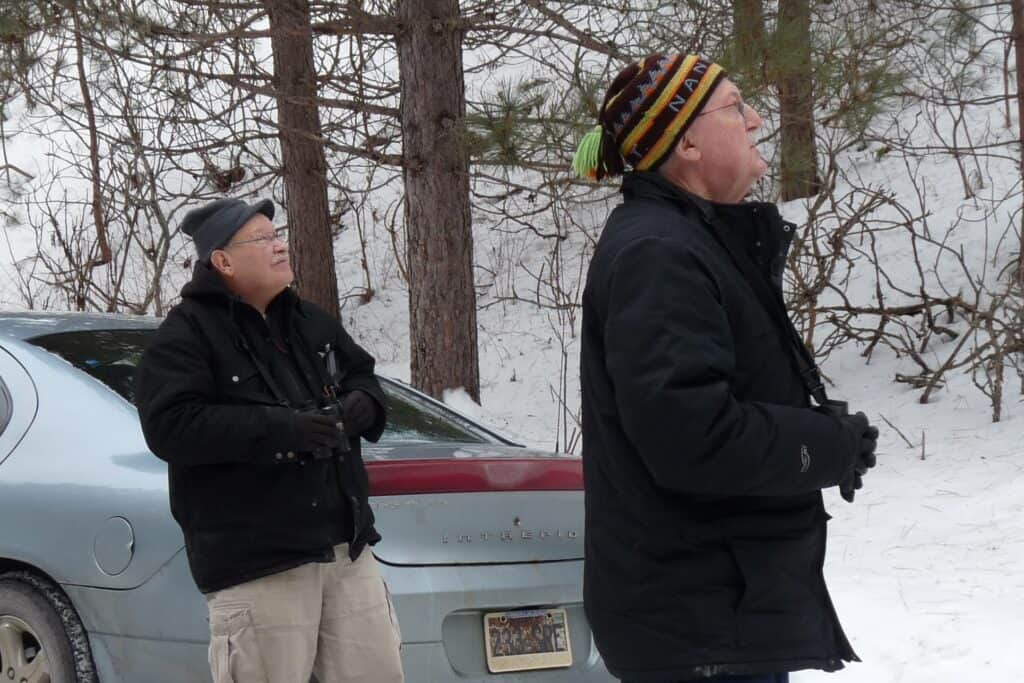Peterborough County has one of the largest and most active birding communities in all of Ontario
Peterborough Examiner – October 6, 2023 – by Drew Monkman
It’s a well-known fact that Peterborough is very much a hockey town. This reputation is well-deserved. What might come as a surprise, however, is that Peterborough also has one of the largest and most active birding communities in all of Ontario. This is a story that warrants telling.
The idea to boast a little about our prominence in ornithology came to me a couple of weeks ago. In late September, the Ontario Field Ornithologists (OFO) held their annual convention here. OFO promotes the appreciation of Ontario’s birds and offers year-round outings. I attended an evening event at which OFO board member and local birder Mike Burrell gave a talk. The theme was why Peterborough is such a popular area for birding. If there’s anyone who has their thumb on the pulse of bird-watching in Ontario, it’s Mike. He is the provincial coordinator for both eBird and BirdingHotspots.org, and the coordinator of the Ontario Breeding Bird Atlas 2021-2025 currently underway. What he had to say inspired and informed my column this week.
Location, location
The rich diversity of birds found here goes a long way to explaining birding’s popularity. Peterborough County sits on the southern edge of the Canadian Shield, a vast area composed of ancient rocks like granite, and on the northern edge of the St. Lawrence Lowlands, a region underlain by younger sedimentary rock like limestone. This mix of northern Shield country and southern lowlands makes for one of the richest assortments of habitat types in all Ontario. Habitat diversity equals bird diversity. This means you can find both Shield species like golden-winged warblers and southern birds like red-headed woodpeckers without leaving the County.
Local birders are also treated to amazing grassland birds like upland sandpipers and bobolinks; wetland denizens like least bitterns and soras; and forest species like warblers, vireos and thrushes. The County is also one of the best places in Ontario to see rarities like great gray owls in years they move southward.
By the numbers
In an average year, about 245 bird species are tallied in the County. Our most active birders routinely see about 225 of these. Over 200 species can be seen during both spring and fall migration and, even in winter, at least 70 are likely. An impressive 180 kinds of birds also breed here.
When you include the many rarities that have turned up over the years, the County’s overall total jumps to an impressive 309 species. Maybe our most famous rarity was a spotted redshank that showed up at the Lakefield Sewage Lagoons in 1981. It somehow came all the way from Europe.
Nearly all birders today submit their checklists on an app called eBird. Peterborough County is number three in all of Ontario for the number of eBird checklists submitted. The only areas that have sent in more are Ottawa and Toronto. When you consider that our population is only 150,000, this is truly impressive. The number of local birders submitting checklists – 3092 at last count – is equally remarkable.
Birds at your doorstep
The many easily-accessible natural areas in and around Peterborough also explain birding’s popularity. Great bird-watching is often just a short walk, bike ride or drive away. Depending on the time of year, you might visit Little Lake, Beavermead Park, the Trent nature areas, the Lang-Hastings Trail, or the Lakefield Sewage Lagoons – to name only a few.
To learn about other hotspots, there’s two options. You can visit https://birdinghotspots.org/ and enter Peterborough. You’ll see a list of the top eBird hotspots. Click on one – Meadowvale Park, for example – and you’ll see photos, a map, and icons for species, directions, and a checklist.
Another option is to go to https://ebird.org/canada/home. Click on Explore Regions. Enter Peterborough, click on Hotspots, and a list of 220 destinations will appear. Click on any hotspot and then on Bar Charts to see the seasonal abundance of each species. Sandy Point on Pigeon Lake will be great for ducks in a couple of weeks!
Four big influences
There are other reasons why birding has mushroomed here. A big one is Trent University. Trent has hosted courses in ornithology for decades. This is largely thanks to the efforts of Dr. Sarah Jamieson who studies bird behaviour and Dr. Erica Nol, an international shorebird expert. Many graduate and undergraduate students under their supervision have become very skilled and active birders. They include Scott Gibson, a fish ecologist with the Ministry of Natural Resources and Forests (MNRF) and Dr. Doug Tozer, who works on waterbird conservation for Birds Canada, the leading bird conservation organization in the country.

Fleming College has also played an important role in birding’s popularity thanks to professors like Don McLeod and courses with a focus on fish and wildlife. Graduates of Fleming’s Conservation Biology program can now seamlessly transfer into similar programs at Trent to get their degree. This brings many students to Trent each year that already have good naturalist and birding skills. One of these is Henrique Pacheco who was the emcee at the OFO Convention.
The influence of MNRF is also significant. When the ministry moved its head office to Peterborough, it brought many wildlife biologists to the area. During their off hours, many spent time birding and contributing to community science projects. A number have also retired here and are active in groups like the Peterborough Field Naturalists (PFN) and the Kawartha Land Trust. Ontario Parks and Species at Risk are also headquartered here and have many active birders in their fold.
Finally, the role of the Peterborough Field Naturalists has been enormous. A whole generation of birders was mentored by the late PFN president Doug Sadler, one of Ontario’s finest naturalists and writers. In addition to myself, they include Martin Parker, a huge contributor to the success of the PFN, an OFO trip leader and co-coordinator of the Atlas; Doug McCrae, a founding member of OFO and trip leader with Worldwide Quest; and Peter Burke, an internationally-known bird artist and trip leader. In 1983, Sadler wrote the first summary of the birds of Peterborough County in his wonderful book entitled “Our Heritage of Birds”. Other former PFN members who have made huge contributions to our knowledge of local avifauna include Tony Bigg, Geoff Carpentier, Fred Helleiner, Clayton Vardy, King Baker, Jim Cashmore, Bill McCord, and Quentin Brown.
The PFN is one of the largest and most active naturalist clubs in Ontario and has long offered year-round birding outings. This is thanks to talented leaders like Jerry Ball and Scott McKinlay. In year’s past, The club was also instrumental in having Peterborough certified as a Bird Friendly City.


Other contributors
There are many, many other people who have made huge contributions to our knowledge of birds in Peterborough County and beyond. Here are but a few.
- Bill Crins – A retired MNRF botanist, Bill has added substantial historical records to the Peterborough regional bird list.
- Jody Allair – A Peterborough native and avid teen birder here, he is now Director of Community Engagement for Birds Canada.
- Chris Risley – A retired Species at Risk biologist, Chris has been deeply involved in monitoring bird populations for years, including at risk chimney swifts in downtown Peterborough.
- Ken Abraham – Now retired from MNRF, Ken is an international expert on waterfowl.
- Don Sutherland – A former zoologist at the Natural Heritage Information Centre in Peterborough, Don is an Atlas co-coordinator and was lead editor on the previous Atlas. He is considered Ontario’s finest naturalist.
- Joe Pitawanakwat – An Anishinaabe researcher and educator who now lives in Peterborough, Joe is working to create a guide that will catalogue the names of birds in Anishinaabemowin.
- Dave Milsom – A retired principal, Dave is the trip organizer for OFO and leads birding trips throughout Ontario and the world.
- Tim Dyson – Tim’s knowledge of the raptors of the Kawarthas is second to none. His work trapping and tagging owls like the northern saw-whet and great gray has contributed a great deal to our knowledge of these birds in the Kawarthas.
- Dave Ellis – A local wildlife photographer, Dave share’s his amazing captures of birds and other wildlife in Peterborough This Week. Photography can be a gateway to birding.
- Cathy Douglas – also retired from MNRF, Cathy is a gifted and relentless birder. She has seen the third most species in the County this year. Fully one-third of Peterborough’s 25 most active birders are women.
- Luke Berg and Matthew Tobey – Only now in their early twenties, Luke and Matthew have been elite birders for at least a decade. Along with up-and-comers like 13-year-old Leo Weiskittel, it’s wonderful to see such passion for nature in young people.
There’s no need to be an expert to enjoy birding. I just hope these individuals serve as inspiration. Nogojiwanong, Ojibwa for “place at the end of the rapids” – and now Peterborough – is a wonderful place to get out and enjoy birds. I hope to see you in the field.